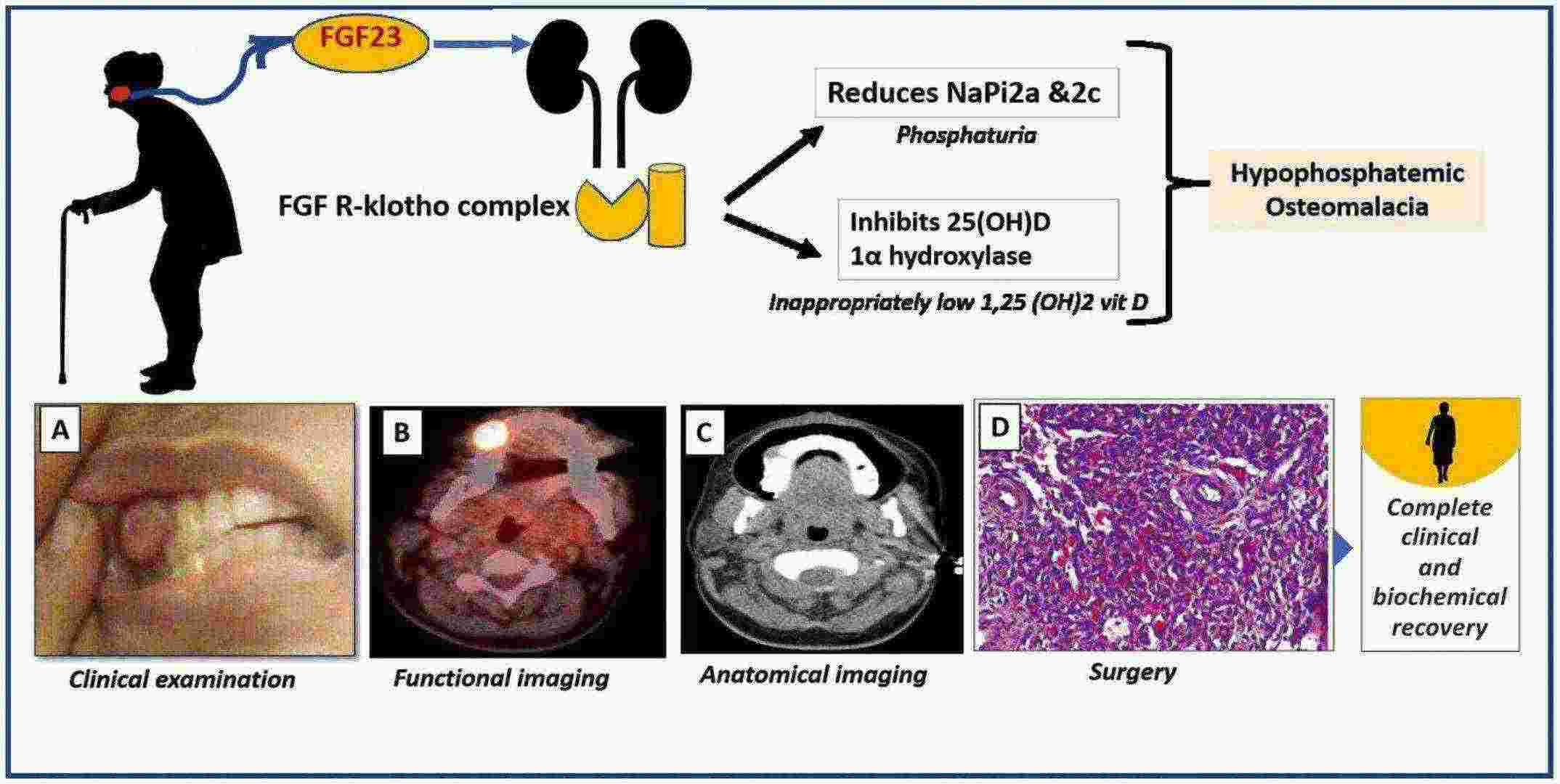Tumor-Induced Osteomalacia
Tumor-induced osteomalacia represents a unique paraneoplastic syndrome characterized by the onset of osteomalacia, a condition marked by the softening of bones. In the realm of therapeutic advances for rare diseases, our company has emerged as a frontrunner, offering a comprehensive array of specialized services that cater to the distinctive needs of researchers and scientists within this particular domain.
Overview of Tumor-Induced Osteomalacia
The prevalence of tumor-induced osteomalacia is strikingly low, estimated to affect no more than 0.70 individuals per 100,000 in the general population. The underlying mechanism of tumor-induced osteomalacia revolves around the existence of small, slow-growing benign phosphaturic mesenchymal tumors (PMTs) that can manifest anywhere in the body, varying from the cranial region to the distal extremities, residing within both soft tissue and bone structures.
 Fig.1 Overview of tumor-induced osteomalacia. (Jadhav, S. S., et al., 2024)
Fig.1 Overview of tumor-induced osteomalacia. (Jadhav, S. S., et al., 2024)
Pathogenesis of Tumor-Induced Osteomalacia
The pathogenesis of tumor-induced osteomalacia is the hypersecretion of fibroblast growth factor 23 (FGF23) by the tumor. FGF23, a pivotal hormone involved in regulating phosphate metabolism within the body, when excessively produced by the tumor, triggers augmented renal phosphate excretion and diminished intestinal phosphate absorption. This deranged phosphate homeostasis ultimately culminates in hypophosphatemia, a systemic state characterized by insufficient levels of phosphate in the bloodstream, disrupting normal bone mineralization processes and giving rise to osteomalacia.
 Fig.2 Interactions between FGF23, vitamin D, and parathyroid hormone. (Minisola, S., et al., 2023)
Fig.2 Interactions between FGF23, vitamin D, and parathyroid hormone. (Minisola, S., et al., 2023)Diagnostics Development of Tumor-Induced Osteomalacia
Diagnosing tumor-induced osteomalacia can be challenging due to its rarity and the nonspecific nature of its symptoms. The following steps are typically involved in the diagnostic process:
Biochemical Tests
Measure the serum phosphate and vitamin D levels, hypophosphatemia and low levels of 1,25-dihydroxyvitamin D are usually observed.
Phosphate Reabsorption Fraction
A renal phosphate wasting test is performed to evaluate the fractional excretion of phosphate and determine if there is excessive renal phosphate loss.
FGF-23 measurement
The intact FGF-23 molecule (iFGF-23) or the cleaved C-terminal fragment (cFGF-23) was detected by enzyme-linked immunosorbent assays.
Therapeutics Development of Tumor-Induced Osteomalacia
| Types | Drug Names | Mechanism of Action | Targets | Research Phase |
|---|---|---|---|---|
| Conventional therapy | Element phosphate/ calcitriol | Partially restore phosphate and vitamin D homeostasis | VDR | Approved |
| Calcimimetic | Cinacalcet | By suppressing PTH levels, it reduces phosphaturia | CaSR | Approved |
| FGFR inhibitors | Infigratinib (BGJ398) | Block the FGF1-FGFR1 signalling pathway to normalize phosphate metabolism | FGFR | Phase II trials |
| Antibody | Burosumab | An anti-FGF-23 monoclonal antibody | FGF-23 | Phase II trials |
Our Services
Our advantages lie in our multidisciplinary approach, combining expertise from various fields such as molecular biology, genetics, and pathology. We understand the unique challenges associated with studying and treating rare diseases, with our animal model and therapeutic development platform, we are committed to advancing knowledge and developing effective therapies.
Therapeutics Development Platforms
Animal Models of Tumor-Induced Osteomalacia
Animal models play a crucial role in understanding the pathophysiology of diseases, including tumor-induced osteomalacia. Our company provides various animal models to support your elucidation of the mechanisms underlying tumor-induced osteomalacia and provide a platform for testing potential therapeutic interventions.

Xenograft models involve the implantation of human tumor cells or tissues into immunocompromised animals.
Optional Models: Cell line-derived xenograft model; PDX Models, etc.

Genetic engineering models involve the genetic modification of animals to overexpress or knock out specific genes.
Optional Models: FGF23 overexpress model, etc.
Why Choose Us
We provide a range of services, including but not limited to pharmacokinetic studies and drug safety evaluations. By fostering collaboration and knowledge exchange, we empower researchers and scientists to accelerate their work toward finding innovative therapeutics for rare diseases.
To embark on a journey of collaboration and exploration, connecting with our team promises a synergistic blend of expertise and resources, propelling your research toward success.
References
- Jadhav, Swati Sachin et al. "Tumor-induced osteomalacia: An overview." Best practice & research. Clinical endocrinology & metabolism 38.2 (2024): 101834.
- Minisola, Salvatore et al. "Tumor-induced Osteomalacia: A Comprehensive Review." Endocrine reviews 44.2 (2023): 323-353.
All of our services and products are intended for preclinical research use only and cannot be used to diagnose, treat or manage patients.
